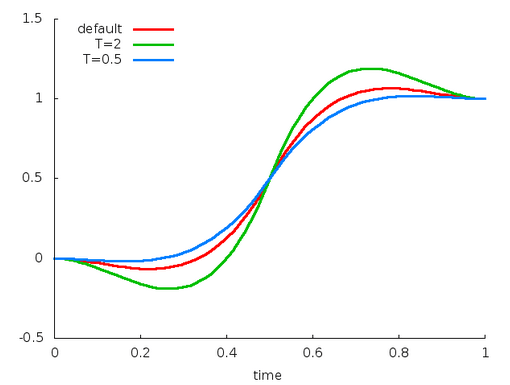本文从源码的角度,来展开对动画的深入解析,关于动画基本用法,可查看Android动画之入门篇(一),Android动画之入门篇(二)。
关于动画有两个非常重要的类,那就是插值器(Interpolators)与 估值器(Evaluators),下面将详细讲解。
一、 插值器
时间插值器,定义了一个时间的函数:y = f(t),其中t=elapsed time / duration.
每个插值器的源码流程都相同,下面以AccelerateInterpolator为例,说明插值器的内部原理:
//系统自带的所有插值器都继承了BaseInterpolator
public class AccelerateInterpolator extends BaseInterpolator implements NativeInterpolatorFactory {
private final float mFactor;
private final double mDoubleFactor;
//无参数的构造方法, factor默认为1
public AccelerateInterpolator() {
mFactor = 1.0f;
mDoubleFactor = 2.0;
}
//有参数的构造方法
public AccelerateInterpolator(float factor) {
mFactor = factor;
mDoubleFactor = 2 * mFactor;
}
//构造方法,通过资源文件获取参数
public AccelerateInterpolator(Context context, AttributeSet attrs) {
this(context.getResources(), context.getTheme(), attrs);
}
/** @hide 隐藏方法,真正用来解析资源文件的方法*/
public AccelerateInterpolator(Resources res, Theme theme, AttributeSet attrs) {
TypedArray a;
if (theme != null) {
a = theme.obtainStyledAttributes(attrs, R.styleable.AccelerateInterpolator, 0, 0);
} else {
a = res.obtainAttributes(attrs, R.styleable.AccelerateInterpolator);
}
//资源文件未定义factor时,默认为1.0f
mFactor = a.getFloat(R.styleable.AccelerateInterpolator_factor, 1.0f);
mDoubleFactor = 2 * mFactor;
setChangingConfiguration(a.getChangingConfigurations());
// 回收TypedArray,释放相应的内存资源
a.recycle();
}
//插值计算的核心方法,定义了插值的映射关系
public float getInterpolation(float input) {
if (mFactor == 1.0f) {
return input * input;
} else {
return (float)Math.pow(input, mDoubleFactor);
}
}
/** @hide */
@Override
public long createNativeInterpolator() {
return NativeInterpolatorFactoryHelper.createAccelerateInterpolator(mFactor);
}
}
其中 BaseInterpolaor实现了Interpolator接口,而Interpolator接口并没有定义任何方法和属性,只是单纯地继承了TimeInterpolator
abstract public class BaseInterpolator implements Interpolator {
private int mChangingConfiguration;
/** * @hide */
public int getChangingConfiguration() {
return mChangingConfiguration;
}
/** * @hide */
void setChangingConfiguration(int changingConfiguration) {
mChangingConfiguration = changingConfiguration;
}
}
TimeInterpolator接口自定义了一个方法getInterpolation,这就是所有插值器最为核心的方法。
public interface TimeInterpolator {
/* * @param input 代表动画的已执行的时间,∈[0,1] * @return 插值转换后的值 */
float getInterpolation(float input);
}
通过分析每一个插值器的插值方法的源码,下面总结了所有插值器的插值函数:
1.1 Linear
- 资源ID: @android:anim/linear_interpolator
- 构造方法:
-
public LinearInterpolator(); //没有任何可调参数
-
- 插值函数:
- 公式:
y=t
- 公式:
- 插值曲线:
1.2 Accelerate
- 资源ID: @android:anim/accelerate_interpolator
- 构造方法:
-
public AccelerateInterpolator();//默认factor=1 -
public AccelerateInterpolator(float factor); -
public AccelerateInterpolator(Context context, AttributeSet attrs); //通过资源文件获取factor值,默认为1。
-
- 插值函数:factor为加速因子,记为f, 默认值为1
- 公式:
y=t^(2f) - 缺省:
y=t^2
- 公式:
- 插值曲线:
1.3 Decelerate
- 资源ID: @android:anim/decelerate_interpolator
- 构造方法:
-
public AccelerateInterpolator();//默认factor=1 -
public AccelerateInterpolator(float factor); -
public AccelerateInterpolator(Context context, AttributeSet attrs); //通过资源文件获取factor值,默认为1。
-
- 插值函数:factor为减速因子,记为f, 默认值为1
- 公式:
y= 1-(1-t)^(2f), - 缺省:
y= 2t-t^2
- 公式:
- 插值曲线:
1.4 AccelerateDecelerate
- 资源ID: @android:anim/accelerate_decelerate_interpolator
- 构造方法:
-
public AccelerateDecelerateInterpolator(); //没有任何可调参数 资源文件获取factor值。
-
- 插值函数:
- 公式:
y = 0.5cos((t+1)π)+0.5
- 公式:
- 插值曲线:
1.5 Anticipate
- 资源ID: @android:anim/anticipate_interpolator
- 构造方法:
-
public AnticipateInterpolator();//默认tension=2 -
public AnticipateInterpolator(float tension); -
public AnticipateInterpolator(Context context, AttributeSet attrs); //通过资源文件获取tension值。
-
- 插值函数:tension`为张力因子,记为s, 默认值为2
- 公式:
y = t*t*((s+1)t-s), - 缺省:
y = t*t*(3t-2)
- 公式:
- 插值曲线:
1.6 Overshoot
- 资源ID: @android:anim/overshoot_interpolator
- 构造方法:
-
public OvershootInterpolator();//默认tension=2 -
public OvershootInterpolator(float tension); -
public OvershootInterpolator(Context context, AttributeSet attrs); //通过资源文件获取tension值。
-
- 插值函数:tension`为张力因子,记为s, 默认值为2
- 公式:
y = (t-1)(t-1)((s+1)(t-1)+s) + 1, - 缺省:
y = (t-1)(t-1)(3t-1) + 1
- 公式:
- 插值曲线:
1.7 AnticipateOvershoot
- 资源ID: @android:anim/anticipate_overshoot_interpolator
- 构造方法:
-
public AnticipateOvershootInterpolator();//默认tension=3 -
public AnticipateOvershootInterpolator(float tension); //tension = 1.5*tension -
public AnticipateOvershootInterpolator(float tension, float extraTension); //tension = tension * extraTension -
public AnticipateOvershootInterpolator(Context context, AttributeSet attrs); //通过资源文件获取tension值。
-
- 插值函数:tension`为张力因子,记为s
- 公式:
-
y = 2t*t*(2t*s+2t-s), 当t < 0.5时, -
y = 2(t-1)(t-1)(2(s+1)(t-1)+s) + 1 , 当t >= 0.5时,
-
- 缺省:
-
y = 2t*t*(8t-3), 当t < 0.5时, -
y = 2(t-1)(t-1)(8t-5) + 1 , 当t >= 0.5时,
-
- 公式:
- 插值曲线:
1.8 Bounce
- 资源ID: @android:anim/bounce_interpolator
- 构造方法:
-
public BounceInterpolator();//没有任何可调参数
-
- 插值函数:
- 公式:
- y = 8*(1.1226t)^2 ,当 t < 0.3535
- y = 8*(1.1226t - 0.54719)^2 + 0.7 ,当 t < 0.7408
- y = 8*(1.1226t - 0.8526)^2 + 0.9 ,当 t < 0.9644
- y = 8*(1.1226t - 1.0435)^2 + 0.95 ,当 t <= 1.0
- 公式:
- 插值曲线:
1.9 Cycle
- 资源ID: @android:anim/cycle_interpolator
- 构造方法:
-
public CycleInterpolator(float cycles); -
public CycleInterpolator(Context context, AttributeSet attrs); //通过资源文件获取cycles值,默认为1。
-
- 插值函数:cycles`为循环次数,记为c
- 公式:
y = sin(2*c*t*π), - 缺省:
y = sin(2*t*π)
- 公式:
- 插值曲线:
二、 估值器
估值器,用于计算属性动画的给定属性的取值,与属性的起始值,结束值,fraction三个值相关。
每个估值器的源码流程都相似,所有的估值器都实现了TypeEvaluator接口,接口采用泛型,可自定义各种类型的估值器,只需实现如下接口即可:
public interface TypeEvaluator {
/* * * @param fraction 插值器计算转换后的值 * @param startValue 属性起始值 * @param endValue 属性结束值 * @return 转换后的值 */
public T evaluate(float fraction, T startValue, T endValue);
}
2.1 IntEvaluator
用于评估Integer型的属性值,起始值与结束值,以及evaluate返回值都是Integer类型。评估的返回值与fraction成一次函数,即线性关系。
public class IntEvaluator implements TypeEvaluator {
/** * 函数关系:result = x0 + t * (x1 - x0) * * @param fraction * @param startValue 属性起始值,Integer类型 * @param endValue 属性结束值,Integer类型 * @return 与fraction成线性关系。 */
public Integer evaluate(float fraction, Integer startValue, Integer endValue) {
int startInt = startValue;
return (int)(startInt + fraction * (endValue - startInt));
}
}
2.2 FloatEvaluator
用于评估Float型的属性值,起始值与结束值,以及evaluate返回值都是Float类型,同样也是线程关系。
public class FloatEvaluator implements TypeEvaluator {
/** * @param fraction * @param startValue 属性起始值,float类型 * @param endValue 属性结束值,float类型 * @return 与fraction成线性关系。 */
public Float evaluate(float fraction, Number startValue, Number endValue) {
float startFloat = startValue.floatValue();
return startFloat + fraction * (endValue.floatValue() - startFloat);
}
}
2.3 ArgbEvaluator
用于评估颜色的属性值,采用16进制。将ARGB四个量,同步进行动画渐变,同样也是采用线性的。
public class ArgbEvaluator implements TypeEvaluator {
private static final ArgbEvaluator sInstance = new ArgbEvaluator();
/* * @hide * 貌似采用单例的方式,可该方法确实@hide隐藏方法,同时并没有将构造方法定义为private。 * 意味着单例对于上层开发者来说是不可见的,这样单例就没有起效果,google难道只是为了framework * 的单例使用,很诡异的设计。 */
public static ArgbEvaluator getInstance() {
return sInstance;
}
public Object evaluate(float fraction, Object startValue, Object endValue) {
int startInt = (Integer) startValue;
int startA = (startInt >> 24) & 0xff;
int startR = (startInt >> 16) & 0xff;
int startG = (startInt >> 8) & 0xff;
int startB = startInt & 0xff;
int endInt = (Integer) endValue;
int endA = (endInt >> 24) & 0xff;
int endR = (endInt >> 16) & 0xff;
int endG = (endInt >> 8) & 0xff;
int endB = endInt & 0xff;
return (int)((startA + (int)(fraction * (endA - startA))) << 24) |
(int)((startR + (int)(fraction * (endR - startR))) << 16) |
(int)((startG + (int)(fraction * (endG - startG))) << 8) |
(int)((startB + (int)(fraction * (endB - startB))));
}
}
三、小结
本文主要分两部分,插值器与估值器。通过源码方式概括性分析插值器的代码实现方式;再从数学角度,逐一进行剖析系统自带的9种插值器的插值函数以及其插值曲线。对于3种Evaluators,通过分析源码,其方式较为简单,需要注意的一点是evaluate中的fraction是插值器转换后的值,而不是elapsed time。








